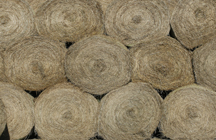Drought leaves hay and livestock producers high and dry
August 10, 2012
 |
|
Drought that has ravaged much of the nation has decreased
hay supplies and increased forage prices. (Purdue Agricultural Communication photo/Tom
Campbell) |
WEST LAFAYETTE, Ind. - Indiana's hay crop is struggling toweather the drought, leaving livestock producers to search for alternativefeedstuffs for their herds and flocks.
The state's alfalfa crop, while high in quality, is low inquantity after a spring freeze reduced the first cutting and drought reducedsubsequent cuttings. Drought also has wreaked havoc on other grass hay sourcesand pastures.
"This definitely is a problematic year andscenario," said Keith Johnson, Purdue University Extension foragespecialist. "The hay yield certainly is depressed. I wouldn't be surprisedif the yields were off by 50 percent for some producers."
In a more normal year, and with proper management, Indianaalfalfa producers could have as many as five cuttings. This year's crop likely willonly be harvested three times in many regions of the state.
Alfalfa quality hasn't suffered like the quantity has.
"The quality of the crop is probably the silverlining," Johnson said. "Alfalfa is a drought-tolerant plant, so whathappens in a dry weather scenario is that you have more leaf as compared tostem than you would in a more normal year. Leaves are what have thequality."
That hasn't been the case for other hay sources, however.
In recent weeks, the U.S. Department of Agriculture hasreleased Conservation Reserve Program land for haying and grazing in manyIndiana counties, but drought has ransacked vegetation on those acres, as well.
"The quality of CRP hay is certainly not forlactating dairy cows but, rather, for dry beef cows or dry ewes that haveweaned offspring and have lesser quality needs," Johnson said. "Thequality of that hay is not going to be exceptional."
The short hay crop and high demand mean livestockproducers already are paying almost twice what they might in a normal year.Johnson said he has seen high-quality hay sell for as much as $300 per ton atnorthern Indiana hay auctions. In years with normal hay yields, the crop sellsfor around $150-$175 per ton.
Those prices are a strain on the already-tight budgets oflivestock producers - some of whom already are reducing their herds.
Johnson emphasized those producers who want to maintainherds need to plan ahead for winter feed supplies. Hay isn't likely to beavailable by the time winter rolls around.
"I think most producers have an idea of the number ofbales they will need to feed the number of livestock they have," he said."What's happened is that hay that was made early in the season, which wassupposed to be stored for feeding in late fall into the winter, is now beingfed in the middle of summer.
"Producers really need to keep track of where theyare with that and not be caught in a short supply when they have no time toreact to it."
One management practice Johnson suggested is to limitanimals' hay access time to 8-12 hours a day instead of 24. Doing so is morelabor-intensive, but reduces hay waste.
"Yes, it's an extra hassle to do that, but in diretimes producers have to be willing to take some extra steps if they want tokeep as much of the livestock operation intact as possible," he said.
Other options include looking to other feed resources,such as crop residues left over from corn harvest, or even the drought-stressedcorn crop that might not have grain potential.
"Once cleared by crop insurance adjusters, cornfarmers and livestock producers could potentially make transactions to turnthat corn into a silage crop," Johnson said. "An option certainly isto cull the herd, but if we are wise about this, we can look to otherresources."
A series of publications have been compiled on the Droughtand Forage Management website at http://www.agry.purdue.edu/ext/corn/cafe/drought/forages.html
More Purdue Extension drought resources are available at http://www.purdue.edu/drought
Writer: Jennifer Stewart, 765-494-6682, jsstewar@purdue.edu
Source: Keith Johnson, 765-494-4800, johnsonk@purdue.edu
Ag Communications: (765) 494-2722;
Keith Robinson, robins89@purdue.edu
Agriculture News Page

